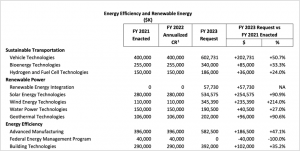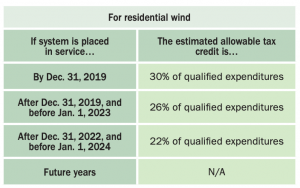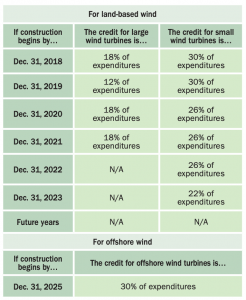LEGISLATION/INITIATIVES
In FY 23, the U.S. Department of Energy (DOE), through the Office of Energy Efficiency and Renewable Energy (EERE), requested $345,390 million for Wind Energy Technologies (WETO), which is an increase of 214% from what was enacted in FY21.[1]

Source: Department of Energy FY2023 Congressional Budget Request (Volume 4)
“Wind Energy Technologies ($345,390,000) supports an updated and expanded portfolio of research and innovation to accelerate the advancement and deployment of offshore, land-based, and distributed wind energy technologies and their integration with the electric grid. Progress in technology, grid systems integration, and unique solutions to deployment challenges, will drive an increase in American-made wind energy and create good paying jobs with the free and fair chance to join a union and bargain collectively. Critical near-term efforts to accelerate deployment include significantly increased support for R&D of technologies to reduce environmental and siting barriers to land-based and offshore wind, as well as efforts to partner with industry, communities, utilities, and other stakeholders to remove barriers to distributed wind deployment. To realize wind energy’s full potential to the U.S. power system, Wind Energy Technologies will aggressively pursue continued innovation and cost-reduction by capturing economies of scale. Additionally, WETO will expand efforts to develop larger, light-weight turbines that allow operation at greater heights, platforms, and turbine designs to enable ultralarge floating wind turbines to access the 58 percent of U.S. offshore wind resources that are in deep water. The Request also supports research to maximize production and efficiency from individual turbine siting and operation within a wind facility. The Request also supports critical R&D to expand U.S. manufacturing capacity and domestic job creation, including manufacturing innovations to enable highly flexible, rail-transportable blades, and support to domestic offshore wind advanced manufacturing, supply chain development, and recycling. The Request also substantially increases funding to support the integration of wind into a cost-effective, reliable, secure, and resilient power grid. In addition, the Request increases support for cross-technology investments that leverage wind energy technologies, including a new effort to integrate and demonstrate a multi-megawatt water electrolyzer coupled with wind power generation to produce low-cost, emissions-free hydrogen, and to demonstrate the robustness of grid services, such as frequency regulation, load following, and contingency reserves.” [2]
The three primary objectives emphasized by WETO are:
- Reduce the cost of wind energy for all wind applications (offshore, land-based utility-scale, and distributed);
- Enable and facilitate the interconnection and integration of substantial amounts of wind energy into the dynamic and rapidly evolving energy system, that is cost-effective, cyber-secure, reliable, and resilient, and includes systems integrated with other energy technologies, energy storage, and offshore and inter-regional transmission planning; and
- Accelerate the deployment of wind energy through siting and environmental solutions to reduce environmental impacts, minimizing timetables for wind energy project development, and facilitating responsible, sustainable, and equitable development and delivery of wind energy resources.[3]
More detailed information pertaining to the FY2023 budget and wind technology is available in the Department of Energy FY2023 Congressional Budget Request (Volume 4).
Renewable Electricity Production Tax Credit
As noted by EIA, “the timing and magnitude of wind turbine installations in the United States are often driven by tax incentives.” [4]
The renewable electricity production tax credit (PTC) is a per kilowatt-hour (kWh) federal tax credit included under Section 45 of the U.S. tax code for electricity generated by qualified renewable energy resources. The PTC provides a corporate tax credit of 1.3 cents/kWh for electricity generated from landfill gas (LFG), open-loop biomass, municipal solid waste resources, qualified hydroelectric, and marine and hydrokinetic (150 kW or larger). Electricity from wind, closed-loop biomass and geothermal resources receive as much as 2.5 cents/kWh.[5]
At the end of December 2020, Congress extended the PTC at 60% of the full credit amount, or $0.018 per kWh ($18 per megawatthour), for another year through December 31, 2021. In 2020, the credit was 60% of the full credit amount. Under the new PTC legislation, qualifying wind projects must begin construction by December 31, 2021.[6]
In April 2022, the IRS released an inflation adjustment for the renewable energy production credit amount.
The credit for renewable electricity production for calendar year 2022 under section 45(a) is 2.7 cents per kilowatt hour on the sale of electricity produced from the qualified energy resources of wind, closed-loop biomass, and geothermal energy, and 1.4 cents per kilowatt hour on the sale of electricity produced in open-loop biomass facilities, landfill gas facilities, trash facilities, qualified hydropower facilities, and marine and hydrokinetic renewable energy facilities.[7]
In terms of utility-scale wind projects, the PTC provides a tax credit of 1¢–2¢ per kilowatt-hour for the first 10 years of electricity generation. The alternative Investment Tax Credit (ITC) provides a credit for 12%–30% of investment costs at the start of the project. Congress passed extensions of the PTC and ITC in December 2020 for 1 year. Additionally, Congress established a 30% ITC for any offshore wind project that begins construction by December 31, 2025 or began construction before January 1, 2017.

Source: U.S. Department of Energy, EERE, WINDExchange
Business Energy Investment Tax Credit
The Business Energy Investment Tax Credit (ITC) is a federal income tax credit for capital investments in renewable energy projects. This one-time credit is based on the dollar amount of the investment and earned when the equipment is placed into service. Owners and developers of large wind energy facilities (either land-based or offshore) that begin construction prior to 2022 can choose to claim the ITC in lieu of the Renewable Energy PTC. The value of the credit depends on when the facility begins construction.
Credit for small wind turbines (100 kilowatts or less) varies depending on when construction begins. Small wind turbines must meet the performance and quality standards set forth by either the American Wind Energy Association Small Wind Turbine Performance and Safety Standard 9.1-2009, or the International Electrotechnical Commission 61400-1, 61400-11, and 61400-12 (IEC). Owners and developers of offshore wind facilities that commence construction prior to 2026 are eligible for a 30% tax credit.[8] The following table details the credits for large and small land-based wind turbines, based on when construction begins, and that for offshore wind projects with construction beginning by December 31, 2025.
Source: U.S. Department of Energy, EERE – Advancing the Growth of the U.S. Wind Industry
Residential Renewable Energy Tax Credit
Taxpayers who purchase and install a qualifying residential small wind electric system (100 kilowatts or less) may claim the Residential Renewable Energy Tax Credit on every kilowatt-hour of electricity generated for the power grid annually for a period of 10 years after a system is placed into service. Systems must be placed into service on or before Dec. 31, 2023. The law provides for a gradual phase-down of this credit, which will decrease annually as outlined below. The credit applies to existing homes, newly constructed homes, principal residences, and second homes but not rental properties. There is no maximum credit.[9]

Source: U.S. Department of Energy, EERE – Advancing the Growth of the U.S. Wind Industry
New Markets Tax Credit
The New Markets Tax Credit (NMTC) program is an incentive supporting community development, job creation, and economic growth, as it attracts private investment for underserved communities. Through this program, individual and corporate taxpayers can receive federal income tax credits in exchange for making equity investments in vehicles certified as Community Development Entities (CDEs) by the U.S. Department of the Treasury’s Community Development Financial Institutions Fund. An investor in a CDE will receive a tax credit equal to 39% of the cost of the investment over a seven-year period (in addition to the returns on investment). The CDEs use the capital raised to provide financing for environmentally-sustainable projects in low-income communities.[10]
Rural Energy for America Program (REAP) Renewable Energy Systems & Energy Efficiency Improvement Loans & Grants
Through REAP, the U.S. Department of Agriculture (USDA) provides agricultural producers and rural small businesses with loan guarantees for energy efficiency improvements and renewable energy systems, including small and large wind generation projects. The REAP program provides guarantees on loans for up to 75% of the total eligible project cost. However, applicants must provide at least 25% of the project cost and demonstrate sufficient revenue to repay the loan and cover any operation and maintenance expenses. REAP was originally established through the 2002 Farm Bill, but it was reauthorized in the 2014 Farm Bill.[11]
Title XVII Innovative Clean Energy Loan Guarantee Program
The Title XVII Innovative Clean Energy Loan Guarantee Program was established by the Energy Policy Act of 2005. This program encourages the financing of energy efficiency, renewable energy, and advanced transmission and distribution projects. The loan program authorizes the DOE Loan Programs Office to guarantee the debt on energy production or manufacturing facilities associated with a range of energy technologies, including renewables. [12]
The Database of State Incentives for Renewables & Efficiency may be a helpful resource in determining state-specific incentives for wind energy.
Federal laws to support the development, implementation, and/or use of wind energy have included:
- Energy Independence and Security Act of 2007
- Energy Policy Act of 2005
- Energy Policy Act of 1992
- Solar, Wind, Waste, and Geothermal Power Production Incentives Act of 1990
Updated by Jennifer Ostromecki, November 2023


Comments are closed.